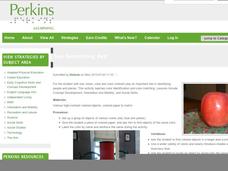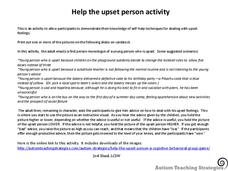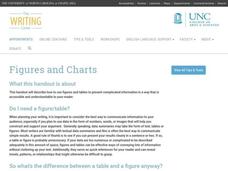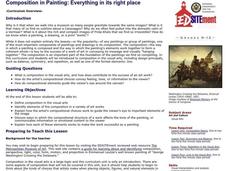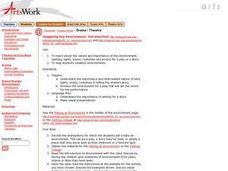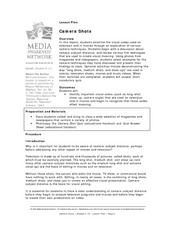Perkins School for the Blind
Design and Problem Solving
What if you had a design problem you wanted to solve, but were unable to draw because you were unable to see? Teach your learners with visual impairments that they can use Wikki Stix®, a braille ruler, Legos®, and Constructo Straws to...
Perkins School for the Blind
Human Body Regulation
The human body can regulate itself through sweating and resting. Learners with visual impairments discuss how the body changes when it is under stress and what it does to regulate itself. To start, kids use talking thermometers to take...
Perkins School for the Blind
I See Something Red
For learners with low vision, the ability to identify colors is an important skill that will help them identify people and places. Groups of brightly colored objects are placed around the room. The child is then given a colored paper and...
Teacher Web
1920's Magazine
What a creative and engaging project to incorporate into your studies of the 1920s! Your young historians will work in groups to design a magazine discussing the political and cultural topics of the decade, each member writing one...
Curated OER
How Many?
Establish 1:1 correspondence by counting students, first one gender, then the other. Give each child a colored cube (one color for boys, another for girls) and have small groups determine more or less and how many all together. As a...
J. Paul Getty Trust
O Greek Shape! O Fair Pose!
Everything old is new again. The Los Angeles J. Paul Getty Museum presents a lesson plan on how Greek black-figure painting influenced eighteenth century Neoclassical artists. After looking at a series of examples, class members create...
Curated OER
Shoes and the Backyard Landscape
Your shoes get a lot of mileage in familiar places. Represent the places you have traveled the most with an art project based on a print of Indian People Wear Shoes and Socks by Juane Quick-to-See Smith. Kids trace their shoes and...
Illustrative Mathematics
Cup of Rice
Dividing with fractions is not a favorite task, so provide your learners with a visual understanding. The activity breaks a simple division problem into something they can comprehend. Use this method for future problems with...
Perkins School for the Blind
Safety Crash Testing
Everyone knows that cars have safety features, but wouldn't it be fun to design your own? Learners with visual impairments build a ramp and then attempt to use the material provided to design a safety system to protect a raw egg from a...
Curated OER
Girders and Wrecking Ball Activity
As learners build the "girders" of conversation by staying consistent on a particular topic, they avoid the "wrecking ball" of an off-topic comment. To help students develop this important conversation skill, this resource provides...
Curated OER
Help the Upset Person Activity
Assess what self-help techniques your students know for dealing with upset emotions with this conversational activity. The teacher begins by role playing as an upset individual, using visual images as prompts, and then asks students...
University of North Carolina
Figures and Charts
Sometimes words aren't the best way to get information across to the reader. The eighth handout in the 24-part Writing the Paper series describes different type of figures and charts to display complex information in a paper....
National Woman's History Museum
Propaganda and Women's Suffrage
Americans who backed the suffragist movement used posters to gain the support of others for their cause. Class members analyze the visual imagery and propaganda devices used in a variety of these posters. In addition, groups examine how...
Curriculum Corner
Book Study: The Polar Express
All aboard! Pair a reading of The Polar Express by Chris Van Allsburg with a set of literacy activities. The packet of worksheets includes task cards, sorting activities, a synonym match, comparing and contrasting activities, writing...
Creative Visions Foundation
Visual Interpretations of the CRC
How can people better understand the human rights that are guaranteed to children around the world? Pupils attempt to answer the question with the second of two lessons explaining the Introduction to the Convention on the Rights of the...
Curated OER
Visual Sum and Difference Word Problems
Aside from awkward wording, this worksheet has problems for learners to solve. They read each problem then use the provided pictures to solve. Note: The images and language are misleading on this worksheet and may be confusing for...
Curated OER
Rhythm and Art: Painting
Students make connections between music and visual art. In this integrated arts lesson, students design paintings that challenge them to examine the relationship between art elements and principles.
Curated OER
Me, Myself, and I
Students visually express their personalities using writing and PhotoShop. They manipulate imagery to illustrate their written description of themselves. Students display their creations.
Curated OER
Everything in Its Right Place: an Introduction To Composition in Painting
High schoolers complete a variety of activities as they study the basics of artistic composition in the visual arts.
Curated OER
Self-Portrait With Literal Reference
Students create self-portraits using ideas from a particular theme and piece of literature in this high school Art instructional activity. Emphasis is placed on combining visual and literal material in a cohesive manner.
Curated OER
Mind Your Pints and Quarts: Making Sense of Liquid Measurement
Elementary and middle schoolers identify different units of liquid measurement. They use the online Visual Thesaurus to learn about the relationships between units of liquid measurement.
Curated OER
Imagining the Environment: Introduction
Learners examine the importance of the environment including the setting, lights, sound, costumes, and props for a play or story. They visualize the appropriate environments and practice applying the techniques.
Curated OER
Camera Shots
Understanding how visual codes such as long-shots, close-ups, and camera angles affect meaning helps prepare young filmmakers to plan their own productions. The concepts embedded could also be used to analyze photographs and paintings.
Curated OER
Exploring Optical Movement in Art
Students describe, represent and analyze patterns and relationships using shapes. They create simple geometric patterns. They demonstrate increasing technical ability and skill to complete visual arts assignments.
Other popular searches
- Visual Arts
- Visually Impaired
- Visual Art Self Portrait
- Visual Art Lesson Plans
- Teacher Resources Visual Art
- Visual Art Lessons
- Visual and Performing Arts
- Visual Art Lessons Symmetry
- Visual Discrimination
- Visual=art
- Visual Art Tessellations
- Visually Impaired Blind




